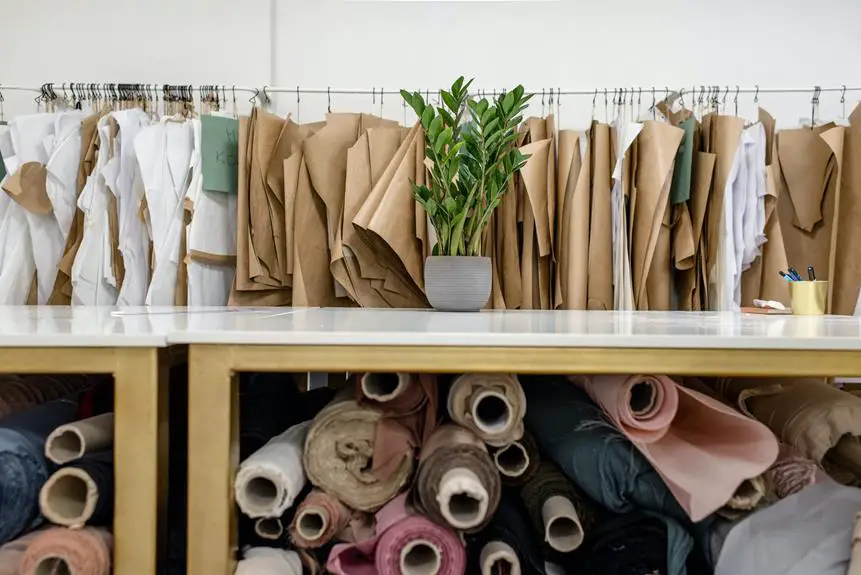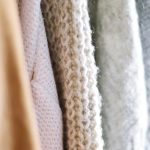So, you've mastered the art of sewing with standard fabrics and are ready to conquer the stretchy ones. In 'How to Sew With Stretchy Fabrics: the Ultimate Guide,' you'll delve into the world of jersey, spandex, and knits with confidence.
This comprehensive guide will equip you with the knowledge to understand stretchy fabrics, select the right needles, and perfect your stitching techniques. Overcome common challenges and elevate your sewing game as you learn to handle stretchy fabrics like a pro.
Whether you're a seasoned seamstress or a beginner looking to expand your skills, this guide will empower you to master the intricacies of sewing with stretchy fabrics.
Key Takeaways
- Stretchy fabrics like jersey, spandex, and knits have elastane or lycra blended with other fibers.
- Select the appropriate needle and thread for stretchy fabrics to prevent skipped stitches and fabric damage.
- Adjust stitch length and width for optimal results and test stitches on a fabric scrap.
- Use a zigzag stitch for seams on stretchy fabrics and consider using a twin needle for hemming.
Understanding Stretchy Fabrics
To sew with stretchy fabrics, you need to understand their unique properties and how they behave when being manipulated. Stretchy fabrics, such as jersey, spandex, and knits, possess the ability to stretch and recover due to their composition of elastane or lycra blended with other fibers like cotton or polyester.
When selecting stretchy fabrics for your sewing projects, consider the weight, stretch percentage, and recovery of the fabric. Light to medium weight stretchy fabrics with good recovery are ideal for garments like t-shirts, leggings, and dresses.
Understanding the fabric properties is crucial for successful sewing. These fabrics have a tendency to curl at the edges, making it essential to stabilize hems and seams. Additionally, using the correct sewing techniques is vital when working with stretchy fabrics. Employing a stretch or ballpoint needle, utilizing a stretch stitch or narrow zigzag stitch, and using a walking foot can help prevent skipped stitches and fabric distortion.
Mastering the art of sewing with stretchy fabrics involves comprehending their properties and employing appropriate sewing techniques to achieve professional-looking results in your projects.
Choosing the Right Needles
When sewing with stretchy fabrics, it's essential to use the right needles to ensure smooth stitching and prevent fabric damage. Choosing the correct needle type can make a significant difference in the outcome of your sewing project.
Here are some important tips to consider when selecting the right needles for sewing with stretchy fabrics:
- Stretch Needles: These needles are specially designed for knit fabrics and can prevent skipped stitches and fabric damage.
- Ballpoint Needles: Ideal for cotton knits and interlock fabrics, these needles have rounded points that allow them to slip between the fabric threads without causing snags or runs.
- Twin Needles: Utilized for creating professional-looking double stitches and hems, these needles are perfect for sewing stretchy fabrics without causing excessive fabric tension.
- Needle Size: Opt for a smaller needle size, such as 75/11 or 80/12, to prevent visible holes and fabric damage.
- Fabric Tension: Ensure that the fabric is properly supported and under minimal tension to avoid stretching or distorting the fabric while sewing.
Choosing the right needles is crucial for achieving high-quality results when sewing with stretchy fabrics. Understanding the different needle types and their compatibility with various fabrics can greatly enhance your sewing experience.
Selecting the Ideal Stitches
When working with stretchy fabrics, selecting the ideal stitches is crucial for achieving professional-looking results. You'll want to consider the stitch length and width that will best accommodate the fabric's stretch while maintaining durability.
Additionally, the use of a zigzag stitch is often recommended for sewing stretchy fabrics, as it allows the seam to stretch without breaking.
Stitch Length and Width
You should always adjust your stitch length and width when sewing with stretchy fabrics to ensure optimal results. Here are some key considerations to help you master this crucial aspect of sewing with stretchy fabrics:
- Stitch Length: Set your machine to a longer stitch length to allow for some give in the seams, preventing them from popping when the fabric stretches.
- Stitch Width: Use a narrower zigzag stitch for better stretch and recovery, as it allows the seam to stretch with the fabric without breaking.
- Test Stitches: Always test your selected stitch on a scrap of the fabric you're using to ensure it provides the necessary stretch and durability.
- Adjusting Tension: Proper tension adjustment is crucial when sewing stretchy fabrics to prevent puckering or loose stitches.
- Fabric Preparation: Preparing your fabric with proper washing and drying can help control its stretch and prevent unexpected changes after sewing.
Use of Zigzag Stitch
To achieve optimal results when sewing with stretchy fabrics, selecting the ideal stitches, particularly the zigzag stitch, is crucial for accommodating the fabric's stretch and preventing seam breakage. When using the zigzag stitch, it's essential to adjust the stitch tension to suit the specific stretchiness of the fabric. A higher tension is suitable for fabrics with more stretch, while a lower tension works best for fabrics with less stretch. This adjustment helps to ensure that the fabric is properly supported and that the stitches can stretch with the fabric without breaking.
Additionally, troubleshooting skipped stitches with the zigzag stitch involves checking the needle size, using a stretch needle for better fabric penetration, and ensuring the fabric is adequately supported and guided through the machine.
Mastering these techniques will result in beautifully sewn stretchy fabric projects.
Handling Jersey, Spandex, and Knits
To successfully sew with stretchy fabrics like jersey, spandex, and knits, start by ensuring that your sewing machine is equipped with a ballpoint needle designed specifically for these materials. This needle type is crucial for preventing snags and runs in the fabric, ensuring a smooth sewing process. Additionally, using a walking foot attachment on your sewing machine can help to feed the stretchy fabric evenly, preventing it from becoming stretched out or distorted during the sewing process.
Here are some essential tips to handle jersey, spandex, and knits effectively:
- Always prewash and dry your stretchy fabric to minimize shrinkage and ensure that your finished garment maintains its shape.
- Use a stretch stitch or a narrow zigzag stitch to allow the seams to stretch with the fabric, preventing them from breaking when the garment is worn or stretched.
- Consider using a twin needle for hemming to create a professional-looking finish that accommodates the fabric's stretch.
- Experiment with different tension settings on scrap fabric to find the optimal balance for your specific stretchy material.
- When cutting out your pattern pieces, use weights or pins to secure the fabric instead of stretching it out on the cutting table, which can distort the shape.
Overcoming Common Challenges
You may encounter some common challenges when sewing with stretchy fabrics, such as difficulties with handling the fabric, choosing the right needle and thread, and adjusting your sewing machine.
These challenges can be frustrating, but with the right techniques and tools, you can overcome them and achieve professional-looking results.
Understanding the properties of stretchy fabrics, selecting the appropriate needle and thread, and making the necessary adjustments to your sewing machine are key to mastering the art of sewing with stretchy fabrics.
Stretchy Fabric Properties
Overcoming the common challenges of sewing with stretchy fabrics requires understanding their unique properties and how they impact the sewing process. When dealing with stretchy fabrics, it's crucial to be aware of their specific characteristics, such as the potential for distortion, curling edges, and difficulty in cutting and sewing.
To help you navigate these challenges and ensure successful sewing with stretchy fabrics, consider the following tips:
- Stretchy Fabric Care: Properly pre-wash and dry your stretchy fabric to minimize the risk of distortion and shrinkage.
- Fabric Stretching Techniques: Use techniques like staystitching and using a walking foot to prevent the fabric from stretching out of shape during the sewing process.
- Needle and Thread Selection: Choose the right needle and thread to accommodate the stretch and weight of the fabric.
- Handling Seam Allowances: Opt for techniques like using a stretch stitch or a narrow zigzag stitch to allow for stretch in the seams.
- Pressing and Ironing: Use a pressing cloth and minimal heat when pressing stretchy fabrics to prevent them from becoming misshapen.
Understanding these properties and how to address them will greatly enhance your sewing experience with stretchy fabrics.
Needle and Thread Selection
Select a needle and thread that match the stretch and weight of your fabric to ensure smooth and secure stitching. Using the wrong needle or thread can result in skipped stitches, puckered fabric, or even damage to the material. When working with stretchy fabrics, ballpoint or stretch needles are ideal as they have a rounded tip that slips between the fabric threads without causing snags. For lightweight stretchy fabrics, a smaller needle size like 75/11 is suitable, while heavier knits may require a 90/14 size needle. Additionally, adjust your sewing machine's thread tension to accommodate stretchy fabrics. Too much tension can cause the fabric to pucker, while too little can result in loose, loopy stitches. Refer to the table below for a quick reference guide:
| Fabric Type | Needle Type | Thread Tension |
|---|---|---|
| Lightweight knits | 75/11 | Slightly reduced tension |
| Medium to heavy knits | 90/14 | Slightly increased tension |
| Lycra or spandex | Stretch needle | Slightly reduced tension |
Sewing Machine Adjustments
To achieve smooth and secure stitching with stretchy fabrics, adjust your sewing machine's settings to overcome common challenges.
Here are five essential adjustments to help you sew stretchy fabrics with ease:
- Tension Control: Adjust the tension settings on your sewing machine to accommodate stretchy fabrics. Lower the tension slightly to prevent the fabric from puckering or stretching out.
- Presser Foot: Use a walking foot or a roller foot to prevent stretchy fabrics from being pulled and stretched as you sew. These specialized presser feet help feed the fabric evenly through the machine.
- Stitch Length: Increase the stitch length to prevent the fabric from bunching up or creating tight, inflexible seams.
- Ballpoint Needle: Use a ballpoint or stretch needle specifically designed for knit fabrics to prevent skipped stitches and fabric damage.
- Test Stitch: Always test your machine settings on a scrap piece of fabric to ensure the adjustments are suitable for your specific fabric.
Mastering Sewing Techniques
Once you have mastered sewing techniques, working with stretchy fabrics will become much easier and more enjoyable. To achieve mastery, it's crucial to understand the properties of stretchy fabrics and how to handle them properly. Additionally, adjusting your sewing machine settings, such as stitch length, is essential for achieving professional-looking results.
Here's a helpful table summarizing key techniques for mastering the art of sewing with stretchy fabrics:
| Techniques | Description | Benefits |
|---|---|---|
| Fabric Properties | Learn about the specific properties of the stretchy fabric you're using, such as its stretch percentage and recovery. | Better understanding of how the fabric behaves when sewn. |
| Stretchy Fabric Handling | Master techniques for cutting, pinning, and handling stretchy fabrics to prevent distortion and puckering. | Reduced fabric waste and improved overall sewing experience. |
| Sewing Machine Adjustments | Adjust the tension, presser foot pressure, and use a ballpoint needle to accommodate stretchy fabrics. | Prevents skipped stitches and fabric damage. |
| Stitch Length | Use a slightly longer stitch length to allow for fabric stretch without causing the stitches to break. | Stronger and more flexible seams. |
| Seam Finishes | Explore different seam finishes such as zigzag stitch, overlock, or coverstitch to prevent unraveling. | Professional-looking and durable seams. |
Mastering these sewing techniques will empower you to confidently work with stretchy fabrics and create beautiful, well-constructed garments.
Frequently Asked Questions
Can I Use a Regular Sewing Machine for Sewing Stretchy Fabrics, or Do I Need a Special Machine?
You can use a regular sewing machine for sewing stretchy fabrics, but using a special machine designed for stretch fabrics can make the process easier. Experiment with different fabric handling techniques to find what works best.
Are There Any Specific Techniques or Tips for Sewing Swimsuit Fabric or Other Highly Stretchy Materials?
When sewing swimsuit fabric or highly stretchy materials, specific techniques are crucial. Use a ballpoint needle, stretch stitch, and walking foot to prevent fabric distortion. Also, consider using swimsuit patterns designed for stretchy fabrics for optimal results.
How Can I Prevent My Stretchy Fabric From Puckering or Stretching Out While Sewing?
To prevent puckering and stretching while sewing stretchy fabrics, stabilize the fabric with a walking foot or ballpoint needle, use a stretch stitch, and adjust the pattern for a better fit. These techniques ensure professional and polished results.
Are There Any Special Considerations for Hemming Stretchy Fabrics, Particularly When Using a Serger or Coverstitch Machine?
When hemming stretchy fabrics with a serger or coverstitch machine, use a stretch needle, adjust machine tension, and stabilize the fabric with a walking foot or tissue paper. Set stitch length and differential feed for optimal results.
What Are the Best Methods for Finishing Seams on Stretchy Fabrics to Prevent Fraying or Unraveling?
When sewing stretchy fabrics, it's crucial to use the right stitch types for seam finishing. Consider using a narrow zigzag or overlock stitch to prevent fraying or unraveling. Make sure to stabilize the fabric and control tension for best results.
- The Pros and Cons of Nonwoven Polypropylene Bags - July 11, 2025
- Key Characteristics of Spunbond Polypropylene Nonwovens - July 11, 2025
- The History and Evolution of Nonwoven Fabrics - July 11, 2025




